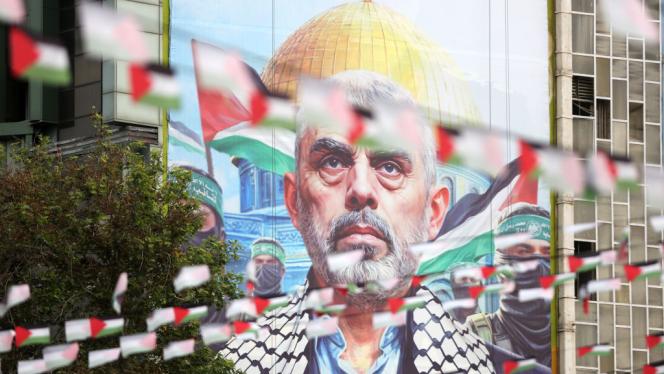Thursday 21 November 2024
When a man becomes a symbol

The footage of Sinwar’s last stand against Israel transformed him from a man into a potent symbol. That image will resonate with Palestinians and people worldwide for generations to come.
Government is a business that is prone to frequent error. Politicians miscalculate, misjudge, or sometimes react impulsively to developments around them instead of strategically considering what the moment demands.
Displaying images of the country’s most wanted man after he has been killed or captured believing that this will dampen resistance to authority and make defiance appear futile is an example of this. It is a display of foolish hubris.
History is full of cases we can reflect on. Che Guevara is perhaps the most obvious: his image has become so widespread in popular culture that few are aware of the original context in which he emerged as an icon for global revolutionaries. In Mexico, Emiliano Zapata—a champion of the rights of disenfranchised rural communities—attained a near-mythic status after being killed by government forces, who displayed his body publicly to prove his defeat. Even Patrice Lumumba of the Congo became a global anti-colonial icon, even though his body was dissolved in acid, leaving only a single tooth as a grim remnant.
Yahya Sinwar’s martyrdom can certainly be added to this list. The Israelis appear to have made a significant strategic communications blunder by releasing drone footage of Yahya Sinwar, wounded and seated on a dusty armchair in the rubble of a demolished building, wielding nothing but a wooden stick and still fighting back. They transformed him from a man into a potent symbol.
Executioners often cannot resist the allure of publicly displaying photographs to boast of their achievements. It vindicates the years they spent crafting a myth around their adversary—a figure portrayed as embodying absolute evil and marked as “wanted dead or alive”.
They project upon these figures’ traits born of their own imaginations, intended to stoke the audience’s fear more than anything. Yet in personifying their enemy, they inevitably fall into the trap set by their own propaganda. For if the conflict centres on a single individual, they must display that person’s end at their own hands, positioning themselves as the fulfilment of their adversary’s fated demise.
This obsession blinds them to the risks of circulating such images, which can easily give rise to a counter-myth. The recklessness displayed by Israeli soldiers, who leaked images before their military eventually released the drone footage, reflects their inability to resist the temptation of presenting Sinwar’s corpse as a trophy that vindicated their actions in the war. They were so elated by their achievement that they unwittingly undermined the ability of their prime minister to define the narrative. Instead, their decision to release the footage inflamed the passions of oppressed people across the region.
The recklessness displayed by Israeli soldiers, who leaked images before their military eventually released the drone footage, reflects their inability to resist the temptation of presenting Sinwar’s corpse as a trophy that vindicated their actions in the war.
Myths are crafted by politicians, biographers, journalists, writers, and the media, with popular culture playing its part as well. Historians later come to dissect these myths. The source of myths is not merely the fabrication of facts, nor is their purpose solely to explain events through storytelling that the historian must later clarify and correct.
Rather, myths are born from the interpretation of images. This is how British literary critic John Berger interpreted Guevara’s final photograph, comparing it to two paintings: Rembrandt’s The Anatomy Lesson of Dr. Nicolaes Tulp and Andrea Mantegna’s The Lamentation of Christ. As is well known, Guevara was executed with nine bullets fired into various parts of his body to make it appear as though he had died in combat. However, this falsehood lasted only a few days before word spread of his execution under orders from the Bolivian president on 9 October 1967.
Images emerged of Sinwar, exhausted, injured, and masked, hurling a stick at a drone after exhausting his supply of bullets and grenades in a skirmish with soldiers who had never imagined they would confront the very man whose name they once used to frighten their children. This image shattered Israel’s long-standing narrative that Sinwar was a leader hiding in tunnels, his life hinging on that of hostages. Sinwar’s final stand and calm acceptance of death captured the public’s imagination, potentially weaving new myths into his legend. Hundreds of fighters have bravely faced death over the past year but in Sinwar the world saw an individual and an emblem that challenged Israel’s narratives and perhaps their own fears as well. His final confrontation and dignified death stood as a defiant response to Israel’s military force, which crushes all that stands in its path—even as Israel and its international and regional allies strive to break Palestinian morale. Unwittingly, Israel amplified Sinwar’s symbolic power by marking him as a prime target of their fury.
This image shattered Israel’s long-standing narrative that Sinwar was a leader hiding in tunnels, his life hinging on that of hostages. Sinwar’s final stand and calm acceptance of death captured the public’s imagination, potentially weaving new myths into his legend.
Apart from interpreting the image of the fighter at the end of his journey in mythic terms, the lives of Guevara and Sinwar otherwise do not intersect. Guevara, an Argentine, was born into a well-off family of Spanish and Irish descent. He studied medicine and embraced Marxism. His epic biography is filled with an impressive array of sports, artistic, literary, and philosophical pursuits from his youth. While he chose to side with the oppressed on moral grounds, he was certainly not one of them. From his motorbike tour across South America, he concluded that there was a common source of injustice throughout the continent, a shared revolution to be fought against a single enemy: American imperialism and its corporations, such as United Fruit, which he viewed as central to the continent's suffering. Guevara joined the Cuban Revolution, eventually becoming a minister, head of the central bank, and an ambassador for Cuba. However, his attempts to ignite revolutionary movements in South America and Africa ended with him isolated, accompanied by only a few dozen fighters in the mountains of Bolivia, among peasants who did not embrace his message and who were unable even to coordinate with other armed groups.
Yet his myth—the myth of challenging oppression in any place and under any circumstances—along with his belief that a revolutionary’s mission is to ignite revolution, spread among leftist youth. His iconic image became a symbol during youth and student protests across western Europe and the United States in 1968, continuing into the early 1970s. Guevara emerged as a symbol of cultural revolt against the establishment, embraced by those it effectively served. However, his influence on actual anti-imperialist or anti-dictatorial struggles remained limited. Some young people adopted his image without fully embracing his call for a global fight against American imperialism and multinational corporations. He became a symbol representing rebellion per se, with people taking the liberty of investing his image with meanings that suit their purposes. After the cold war ended, his image was absorbed into pop culture, evident in art, literature, and cinema. From there, it followed the familiar path into shopping centres, until his likeness adorned coffee mugs and T-shirts. Without the rivalry between capitalism and socialism, which had provided the reference points that gave his symbol with meaning, he was freed from his ideological baggage. This has been described as the “commoditization of his image”.
Sinwar on the other hand was martyred defending his homeland, not someone else’s. Born into a family of Palestinian refugees, he belonged to a poor, oppressed class, living in Gaza among neighbours who shared in their suffering. He had no time for hobbies, nor did he travel across the Arab world searching for monsters and tyrants to slay; his great calling was right there at home. Sinwar entered prison at a young age, which became his school, and the brotherhood of fellow prisoners became his family. After twenty years, he was released back into besieged Gaza, where his movement, Hamas, assumed authority in 2006.
Unlike Guevara, Sinwar didn’t dedicate his life to an abstraction which seduced him. He wasn’t fighting for the idea of a global proletariat and the overthrow of the capitalist system. Sinwar only ever left Gaza once to visit Egypt. He didn’t preach any internationalist dogma or embrace theories related to global revolution. He was driven by a desperate desire for himself and his people to live; a desire shaped by his experiences in the asphyxiating conditions of occupied Gaza. He once said: “You walk to the beach at sunset, and you see all these teenagers on the shore chatting and wondering what the world looks like across the sea. What life looks like… I want them free.”
He didn’t preach any internationalist dogma or embrace theories related to global revolution. He was driven by a desperate desire for himself and his people to live; a desire shaped by his experiences in the asphyxiating conditions of occupied Gaza.
Western consumer capitalism will struggle to appropriate the image of this masked fighter into its gallery of poster boys for rebellion. Even those who sympathise will maintain a strategic silence. Yet what he has come to represent is easy to understand; it is a well-known archetype, which takes different forms in different literary and oral traditions but is familiar to us all. Among Palestinians, the perennial underdogs, it is ubiquitous.
You can find a version of Sinwar in any refugee camp, village, or Palestinian neighbourhood: he doesn’t wear any special attire or seek distinction. His brisk walk, upright posture, and the visible anger on his face, which quickly dissolves into a smile when he greets children, young people, and former prisoners, all reveal something about him.
Sinwar’s spontaneity implies that he does not feign humility without cause. His limited education is enhanced by his intelligence and quick wit, allowing for a seamless shift from intense pragmatism to fierce determination. This is evident in his disappointment at the world’s lack of response to the Great March of Return and the high toll of victims it exacted in a bid to break Gaza’s blockade. He joined a political movement like tens of thousands of other young Palestinians, but it was the armed wing that elevated him to political leadership. That became a means through which he could more forcefully reclaim agency. “Does the world expect us to be well-behaved victims while we’re getting killed?” he rhetorically asked a Vice News interviewer. “That’s impossible.”
Upon his martyrdom, Palestinians, Egyptians, Jordanians, and Arabs and Muslims from east to west felt he was one of their own. Statements by foreign ministries were slower to arrive than for Ismail Haniyeh but they came. And because he was one of their own, their grief mingled with pride amidst the catastrophe. They sympathised with the masked man seated on a couch in an abandoned building, an image steeped with meaning, representing the isolation of the Palestinian resistance, but also its incredible dignity and fearlessness despite that. Western politicians and media struggle or refuse to grasp that.
And so, despite the obvious reality that the Palestinians are an occupied people, fighting a wealthy, nuclear armed, settler colonial state, the meaning of the symbol which Sinwar has become remains contested. For some, he is the epitome of evil, while for others, he has become an icon of dissent, resistance, and stubborn will. Israeli general Giora Eiland understood that. “What matters to Sinwar is land and dignity,” he told a Knesset committee. In this regard, he has also become a shibboleth dividing those who support a colonial entity, systemically cleansing and dispossessing the Palestinian people of their land and those who stand with the victims, whether or not they agree with Sinwar’s choices.






